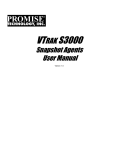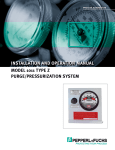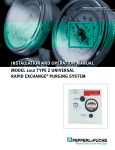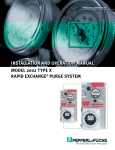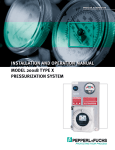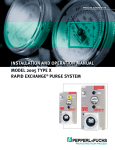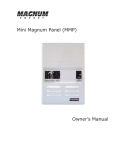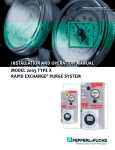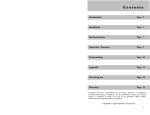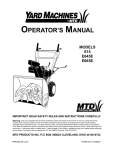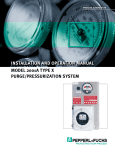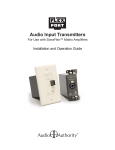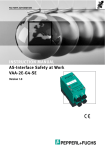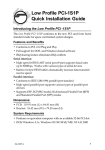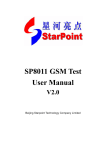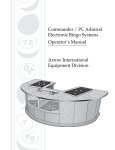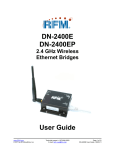Download Model 11 Type Y or Z Purge/Pressurization System
Transcript
PROCESS AUTOMATION INSTALLATION AND OPERATION MANUAL MODEL 11 TYPE Y or Z PURGE/PRESSURIZATION SYSTEM Model 11 Installation and Operation Manual Table of Contents Purpose and Description Page 2 System Purpose and Description Purpose, System description, Important notes Page 3 Identifying Your System Defines specific features of the system Page 3 General Information System & material specifications, System accessories, Spare parts, Tools & test equipment Page 4 Enclosure and Device Design Design requirements, Adjacent enclosures, Device ventilation, Temperature limitations Page 5 Installation Overview Installation diagram Page 6 Getting Started Establishing connection sizes, Determining enclosure inlet & outlet connection locations Page 7 System Mounting LH, RH, TM, BM & WM configurations, FM & PM configurations Page 8 Special Mounting Information ECK, ILFK connection diagram, Typical panel mount diagram Page 9 Mounting Plate Dimensions Mounting plate dimension diagrams Purpose Pepperl+Fuchs' Bebco EPS System allows the use of generalpurpose or nonrated electrical or electronic devices, with exception to devices that produce excessive heat, utilize combustible gas, or expose arcing contacts to the hazardous atmosphere, in NEMA (National Electrical Manufacturers Association) 4 or 12 enclosures in the place of explosion proof NEMA 7 enclosures. Other purposes include heat, moisture and dust contamination prevention. Description Model 11 is an enclosure pressurization or purging system that operates on a supply of compressed instrument air or inert gas. It regulates and monitors pressure within sealed (protected) enclosures, to prevent combustible dust accumulation or remove and prevent flammable gas or vapor accumulations. In Class II areas, the system maintains a “safe” (1.0") pressure. In Class I areas, the system accomplishes four air exchanges and maintains a “safe” (0.25") pressure. These processes reduce the hazardous (classified) area rating within the enclosure(s), in accordance with the NEC - NFPA 70, Article 500, NFPA 496 and ISA 12.4. Important Notes One (1) permanent file copy and one (1) operations copy of this manual must be studied and retained by the operator of this system. User’s agents are responsible for transferring this manual to the user, prior to start-up. Page 11 Hardware Mounting Optional enclosure protection vent, Warning nameplates Page 12 Pneumatic Tubing Requirements Protective gas supply requirements, Pneumatic connection requirements Page 13 Tubing Installation LH, RH, TM, BM, WM, FM & PM tubing configurations Page 14 Tubing Connection Diagrams LH, RH, TM, BM, WM, FM, & PM configuration connection points, Pneumatic diagram Page 15 Electrical Supply Requirements Wiring requirements, Enclosure power & alarm signal, Enclosure wiring methods & connections Page 16 Conduit Installation Electrical & WPS style conduit and connection parts Page 17 Set-Up Procedure Class I & Class II set-up The contents of this manual have been arranged to allow the use of this product as a stand-alone device on equipment and enclosures supplied by the user or its agents. The manual’s parameters encompass a combination of both National Fire Protection Association (NFPA) requirements and Pepperl+Fuchs, Inc. requirements. Pepperl+Fuchs therefore acknowledges the use of NFPA 496 as a guideline, that we have enhanced certain NFPA requirements and that additional information has been compiled to complete this document. The manual is intended as a complete guide and must be considered, unless specifically stated otherwise, that all directives contained herein are requirements for safe, practical and efficient use of this product. This system is not intended for use to protect enclosures or devices that contain ignitable concentrations of gases or vapors. This exclusion generally applies to process or product analyzing systems equipment. All specifications are subject to change without notice. Page 18 Operating Sequence Class I & Class II operation Part No. 512091 Drawing No. 129-0207a 03/09 Page 19 Troubleshooting Procedures Troubleshooting chart Page 20 Warranty and Liability Statement Warranty notes, General terms, Limitations Page 21 Customer Notes Page 22 System Maintenance Regular maintenance, Long-term maintenance, Maintenance schedule Page 23 Systems Identification & Application Information 2 Subject to modifications without notice Pepperl+Fuchs Group USA: +1 330 486 0002 www.pepperl-fuchs.com [email protected] Germany: +49 621 776 2222 [email protected] Copyright Pepperl+Fuchs Singapore: +65 6779 9091 [email protected] = 1X Model 11 Installation and SCALE Operation Manual Identifying Your All dimensions are in inches. All outside corners R=0.13 Tolerances: 2-place .01 In dec. order+/to comply with the NFPA 496 standard requiring System This enclosure protection system is offered in various styles. For proper installation and operation, examine the system model number nameplate to identify the system style, area classification, and type, as noted below. LABEL P/N: 510876 Model 11-LPS-CII Type Y or Z 10 CUBIC FEET MAXIMUM ENCLOSURE VOLUME b) Install a tamper-proof regulator upstream of the enclosure protection system Type supplyY inlet Modelsystem's 11-WPS-CII or to Z pre-regulate protective gas supply to ENCLOSURE 5 psi max. 10 CUBIC FEET MAXIMUM VOLUME TYPE Y: CL.tightly II, DIV. 1, GR.sealed F & G TO CL. II,enclosures, DIV. 2 In addition, for TYPE small, or to Z: CL. II, DIV. 2, GR. F & G TO NONHAZARDOUS compensate for a fluctuating protective gas supply, it may be necessary to pre-regulate the protective gas supply to a constant 5 psi regardless of whether an enclosure protection CONTROL FOR USE IN HAZARDOUS LOCATIONS IN ACCORDANCE WITH THE NATIONAL FIRE vent isPURGE installed. This will reduce the amount of "drifting" that PROTECTION ASSOCIATION STANDARD FOR PURGED AND PRESSURIZED ENCLOSURES FOR ELECTRICAL EQUIPMENT NFPA 496-1996 4S11 can normally occur when maintaining a "safe" pressure inside a APPROVED BY FM APPROVALS AS ASSOCIATED TYPE Y & Z PRESSURIZATION CONTROL E Q U I P M Eenclosure. N T F O R U S E I N H A ZThe A R D O U Spre-regulation L O C AT I O N S . R E D U C E S T H E can I N T E R N Abe L A R Eaccomplished A protected O F A C O N N E C T E D E N C L O S U R E I N A C C O R D A N C E W I T H D R AW I N G N U M B E R 11 - I O M . by installing the TR-10G tamper-proof regulator accessories or equivalent. ® LA S SI FIE D C S SI FIE D C a) Install an enclosure protection vent on the protected enclosure LABEL P/N: 510880 REDUCES INTERNAL AREA CLASSIFICATION AS FOLLOWS: REDUCES INTERNAL AREA CLASSIFICATION AS FOLLOWS: TYPE Y: CL. II, DIV. 1, GR. F & G TO CL. II, DIV. 2 TYPE Z: CL. II, DIV. 2, GR. F & G TO NONHAZARDOUS LA protection against over pressurization of the protected enclosure, the installer must install one of the following items in addition to the enclosure protection system. ® PURGE CONTROL FOR USE IN HAZARDOUS LOCATIONS IN ACCORDANCE WITH THE NATIONAL FIRE PROTECTION ASSOCIATION STANDARD FOR PURGED AND PRESSURIZED ENCLOSURES FOR ELECTRICAL EQUIPMENT NFPA 496-1996 4S11 APPROVED BY FM APPROVALS AS ASSOCIATED TYPE Y & Z PRESSURIZATION CONTROL E Q U I P M E N T F O R U S E I N H A Z A R D O U S L O C AT I O N S . R E D U C E S T H E I N T E R N A L A R E A O F A C O N N E C T E D E N C L O S U R E I N A C C O R D A N C E W I T H D R AW I N G N U M B E R 11 - I O M . 11 - LPS - CI - YZ - LH - ## Series Model Number System Style LPS - less pressure switch WPS - with pressure switch Area Classification CI - Class I Area CII - Class II Area System Type YZ - Div. 1 to Div. 2, Div. 2 to Nonhazardous Mounting Configuration TECHNICAL LH INFORMATION: - left hand left side of enclosure RH - right hand right side of enclosure TM - top mount top of enclosure LABEL MATERIAL: 0.01” BM - bottomPOLYCARB mount bottom of enclosure WM MUST - wall mount wall surface ADHESIVE: BE UL/CSA APPROVED - frame mount external frame or rack COLOR: FM BLACK COPY ON WHITE BACKGROUND PM - panel mount enclosure surface cutout Material Specifications Regulator body: Regulator handle: Enclosure pressure gauge: Tube fittings: Tubing: System nameplates: Fastener hardware: Mounting plate: EXP pressure switch body: Enclosure warning nameplate: Zinc w/ enamel finish Polycarbonate Aluminum w/ enamel finish 316 SS forged body 316 SS 1/4" .035 welded Silkscreened Lexan® & SS Aluminum & stainless steel 316 14 ga #3 brush SS Anodized cast alum. Silkscreened SS Lexan® is a registered trademark of the General Electric Corporation Recommended Spare Parts Qty Description NOTE: FULL INFORMATION (Not PERTAINING TO PRINT FONTS, available in WPS Style) 1 Enclosure pressure indicator-CI DIMENSIONS AND COLOR SCHEMES ARE CONTAINED IN ## - Additional factory installed accessories 1 Enclosure pressure indicator-CII THIS COREL DRAW (.CDR) FILENAME UNDER DRAWING 1 Enclosure pressure control regulator NUMBER 125-0830A Part # (supercedes) 510036 (001050) 510037 (001052) 513315 (002000) 1 Installation & operation manual 129-0207 1 Group C - D pressure switch-CI 510044 (001080) General Information 1Absprache Group mit A -dem D pressure switch-CI 510045 (001085) Dieses Dokument enthält sicherheitsrelevante Angaben. Es darf nicht ohne Normenfachmann geändert werden! 1 Group E - G pressure switch-CII 513242 (001082) This document contains safety-relevant information. It must not be altered without the authorization of the norm expert! System Specifications 1 Enclosure warning nameplate-CI 513008 (EWN-1) Only valid as long as released in EDM or with a valid production documentation! date: 2004-Feb-02 scale: 1:1 Confidential according to ISO 16016 1 Enclosure warning nameplate-CII 513009 (EWN-2) System dimensions: See pages 9 & 10 change notice. respons. US.JMB Label for Model 11-[LPS or WPS]-CII Type Y or Z Shipping weight ( lbs.): LPS - 5, WPS - 10 Please call and reference part number above for current spare 125-0830A US.SSJ approved 11 LPS CII UL+40 Y or°F Z to ID +120 NP SS°F Operating temp. range: 150-0355 pricing is available to all confirmed parts pricing. Immediate 11 WPS CII UL Y or Z ID NP SS sheet 1 of 1 US.WDB norm Twinsburg Supply pressure range: * 5 -120 psi max. customers. Part No. 512091 Drawing No. 129-0207a 03/09 When using the optional inline filter, max. supply pressure is 80 psi Supply requirements: Safe pressure (CI/CII): Safe pressure flowrate: System supply fitting: Enclosure supply fitting: Enclosure reference fitting: Switch setting (CI/CII, decr): WPS & WPSA pressure switch wiring: Switch contact ratings: WPS style: Clean air or inert gas 0.25" / 1.0" ** 0.1-3.5 SCFH 1/4" tube fitting 1/4" tube fitting 1/4" tube fitting 0.15"/0.5" ± 0.02" 1/2" FPT 120 VAC @ 15 A * With enclosure protection vent - 120 psi maximum Without enclosure protection vent - 5 psi maximum Installation Tools & Testing Equipment 1/2" chuck drill Released EDM checkout 2008-JUL- Complete set of drill bits 1/2" conduit knockout punch or 0.875" hole saw Complete set of tubing, conduit bending, instrument fitting and electrical craftsman hand tools 0 - 250 scfh flowmeter (connected upstream of the Protection System to determine air consumption and flow during set-up procedure) **Enclosure integrity determines actual flow rate Subject to modifications without notice Pepperl+Fuchs Group USA: +1 330 486 0002 www.pepperl-fuchs.com [email protected] Germany: +49 621 776 2222 [email protected] Copyright Pepperl+Fuchs Singapore: +65 6779 9091 [email protected] 3 Model 11 Installation and Operation Manual Model 11 System Accessories Total Volume Calculation Optional Enclosure Protection Vents EPV-1-SA-00 Straight w/ spark arrestor EPV-1-SA-90 Rt angle w/ spark arrestor 1. The total volume of all pressurized enclosures, devices and wireways must be considered. Additional Items SMK-1, -4, or -6 EPSK-1 EPSK-1A EPSK-2 GPSK-1 GPSK-2 RAH RAB-1 RAB-2 LCK TCK TR-10G System mounting kit Class I, Group C - D pressure switch kit Class I, Group A - D pressure switch kit Class II, Group E - G pressure switch kit Class I, general-purpose switch kit Class II, general-purpose switch kit Div. 1 remote alarm horn Div. 1 remote alarm beacon Div. 2 remote alarm beacon L fitting conduit kit T fitting conduit kit Tamper-proof regulator w/ gauge 2. All enclosure, device, and wireway volumes must be calculated without consideration of internally consumed space. Device Ventilation 1. Enclosed devices within the protected enclosure which do not exceed 1.22 in3 of free volume do not require ventilation to the protected enclosure. 2. If the free volume of an internal device exceeds 1.22 in3 it must be protected by one of the following means: a) ventilated on the top and bottom sides with 1 in2 of opening for each 400 in3 of volume within the internal protected enclosure, at a minimum diameter of 1/4" b) purged in series with the protected enclosure or be purged separately or Enclosure & Device Design Enclosure Design Requirements 1. All windows must be shatterproof and sized as small as possible. 2. All NFPA 496 required markings must be placed on or near all enclosure doors and covers. 3. The enclosure must withstand an internal pressure of ten (10) inches of water without sustaining permanent deformation and resist all corrosive elements in the surrounding atmosphere. 4. All lightweight objects in the enclosure, such as paper or insulation, must be firmly secured. 5. The enclosure should be constructed from materials such as metal or nonstatic polycarbonate to meet or exceed NEMA 4 or 12 performance requirements, but does not require third party approval. 6. The installation of obstructions or other barriers that block or impede the flow of protective gas must be avoided. 7. The creation of air pockets or other areas that trap flammable gases within the enclosure or devices must be avoided. 8. The enclosure should be located in an area where impact hazards are minimal. c) protected by other means; e.g., explosion proof enclosures, hermetically sealed devices, or intrinsic safe circuits. Temperature Limitations 1. The enclosure must have no surface area that exceeds 80 percent of the flammable or ignitable substance’s autoignition temperature. 2. Internal devices that exceed this temperature must be protected by one of the following manners: a) The device is enclosed in a chamber that is cULus or FM listed as a hermetically sealed device that prohibits the entrance of a flammable or ignitable substance, and maintains a surface temperature below temperature limits. b) It can be proven by testing that the devices will not ignite the substance involved. c) The device is purged in a separate enclosure that bears an ETW (enclosure temperature warning nameplate). Devices may be accessed only after power has been removed and the device has been allowed to cool to safe temperature, or the area is positively known to be nonhazardous. 9. If the enclosure is nonmetallic and contains equipment that utilizes or switches power loads greater than 2500 VA, it must be constructed from substantially noncombustible materials, such as materials designed to meet or exceed ANSI/UL94 ratings of 94 V-0 or 94 5V. Adjacent Enclosures Part No. 512091 Drawing No. 129-0207a 03/09 1. Adjacent enclosures must be protected by one of the following means: a) purged or pressurized in series with the protected enclosure b) purged or pressurized separately or c) protected by other means; e.g., explosion proof enclosures, hermetically sealed devices or intrinsic safe circuits 2. Adjacent purged or pressurized enclosures must be designed to meet all construction requirements above. 4 Subject to modifications without notice Pepperl+Fuchs Group USA: +1 330 486 0002 www.pepperl-fuchs.com [email protected] Germany: +49 621 776 2222 [email protected] Copyright Pepperl+Fuchs Singapore: +65 6779 9091 [email protected] Model 11 Installation and Operation Manual Installation Overview Model 1002-WPS-LH Shown ENCLOSURE PROTECTION VENT PROTECTED ENCLOSURE ENCLOSURE SUPPLY TUBING SYSTEM MOUNTING BOLT ENCLOSURE PROTECTION SYSTEM PROTECTIVE GAS SUPPLY SYSTEM SUPPLY FITTING SERVICE VALVE ENCLOSURE CONNECTION FITTINGS ENCLOSURE REFERENCE TUBING Part No. 512091 Drawing No. 129-0207a 03/09 SYSTEM SUPPLY TUBING ENCLOSURE WARNING NAMEPLATE ELECTRICAL ALARM WIRING CONDUIT & SEAL Subject to modifications without notice Pepperl+Fuchs Group USA: +1 330 486 0002 www.pepperl-fuchs.com [email protected] Germany: +49 621 776 2222 [email protected] Copyright Pepperl+Fuchs Singapore: +65 6779 9091 [email protected] 5 Model 11 Installation and Operation Manual Getting Started Typical Single Protected Enclosure Connections ENCLOSURE PROTECTION VENT (Optional) 1/2" PROTECTIVE GAS SUPPLY HEADER C REFERENCE ENCLOSURE PROTECTION SYSTEM PROTECTED ENCLOSURE SUPPLY A E B A Description *Tubing or pipe diameter Maximum tubing / pipe length and maximum number of bends / elbows C B System supply tubing Enclosure supply Enclosure reference 1/4" O.D. tubing 1/4" O.D. tubing fully reamed fully reamed 20 feet 10 bends D E Multi - enclosure Optional remote venting connections 1/4" O.D. tubing fully reamed 1/2" I.D. pipe fully reamed 20 feet 10 bends 10 feet 5 elbows 5 feet 5 bends 1/2" I.D. pipe fully reamed 30 feet 5 elbows TYPICAL MULTIPLE PROTECTED ENCLOSURE CONNECTIONS B 1/2" PROTECTIVE GAS SUPPLY HEADER ENCLOSURE PROTECTION SYSTEM D PROTECTED ENCLOSURE SUPPLY D PROTECTED ENCLOSURE PROTECTED ENCLOSURE REFERENCE C A *NOTE: Tube and pipe sizes are trade sizes and are not equal in inside diameters. DO NOT substitute tube for pipe with same trade size. HELPFUL HINTS To ensure adequate protective gas flow to the protected enclosure(s), all piping and tubing must be fully reamed. Precautions must be taken to prevent crimping and other damage to protective gas piping and tubing. When protecting multiple enclosures with a single enclosure protection system, the enclosures must be connected in series from the smallest to the largest to ensure adequate protective gas flow. Determining Enclosure Inlet & Outlet Connection Locations OUTLET HELPFUL HINTS OUTLET Connections for heavier than air gases and vapors If flammable gases are heavier than air, inlet and outlet connections must be reversed. INLET Connections for lighter than air gases and vapors 6 Subject to modifications without notice Pepperl+Fuchs Group USA: +1 330 486 0002 www.pepperl-fuchs.com [email protected] If flammable gases are lighter than air, the inlet connection to each enclosure must enter near a bottom corner. The outlet connection, for an optional enclosure protection vent or piping to an adjacent protected enclosure, must exit near an extreme opposite top corner. In all cases, the most prevalent gas must determine the location of inlet and outlet connections. Germany: +49 621 776 2222 [email protected] Copyright Pepperl+Fuchs Singapore: +65 6779 9091 [email protected] Part No. 512091 Drawing No. 129-0207a 03/09 INLET Model 11 Installation and Operation Manual System Mounting IMPORTANT NOTES Pipe mounting systems without ECK accessory The system should be mounted at EYE LEVEL. 1. Locate 2" schedule 40 pipe, (vertical for LH & RH, horizontal for TM & BM) within five (5) feet of protected enclosure. Care must be taken to ensure the system and all protruding components are clear of all enclosure accesses (doors and covers) and conduit, pipe, tubing or cable entries. LH, RH, TM, BM and WM configurations are intended for mounting adjacent to the protected enclosure. LH, RH, TM & BM configurations are also suitable for 2" schedule 40 pipe mounting. In addition, these configurations can be accessorized with an ECK (Enclosure Connection Kit). See page 8. Systems furnished with a Model ECK are not compatible for pipe mounting or multiple enclosure applications. Determine the mounting configuration of your system using the diagrams on pages 9 and 10. Remove and save the manila envelope (containing the enclosure warning nameplate) which may be taped to the outer surface of the mounting flange. Although all systems are factory tested and calibrated, we strongly suggest a bench test of basic functions prior to installation. Mounting LH, RH, TM, BM & WM Configurations Surface mounting systems with ECK accessory 1. Verify dimensions of the system’s mounting holes and connection fittings in reference to the applicable drawing on pages 9 and 10. 2. Upon confirmation of dimensions, transfer mounting hole pattern from drawing to the intended surface. 3. Check for internal obstructions that could hinder bolt fastening and protective gas flow, drill and ream the mounting holes before mounting the system. 2. Ensure system is mounted in a true vertical position, secure the system to pipe, using one (1) a PMK-1 mounting kit or equivalent - two (2) 1/4" x 2" stainless steel “U” bolts, nuts and lock washers. Mounting FM & PM Configurations HELPFUL HINTS FM and PM configurations are designed to mount through a panel cutout one (1) inch smaller than the overall height and width of the system mounting plate, using clips and fasteners provided with SMK -4. This design feature eliminates the need to drill the system mounting bolt holes in the protected enclosure. FM configurations are intended for mounting adjacent to the protected enclosure. PM configurations are intended for mounting through a cutout in the protected enclosure surface. 1. Transfer panel cutout pattern to the intended surface. 2. Check for obstructions that could prohibit bolt fastening or system pneumatic connections. 3. Cut panel cutout pattern on the intended surface. 4. Deburr all cutout surfaces. 5. Secure system to enclosure using SMK-4 or equivalent 1/4" x 3/4" stainless steel nuts, bolts, mounting clips and lock washers. 4. Remove locknuts on enclosure connection fittings. 5. Secure the system to the protected enclosure using one (1) SMK-1 or equivalent - four (4) 1/4" x 3/4" stainless steel bolts, nuts and lock washers. 6. Install the locknuts on the enclosure connection fittings from inside of the protected enclosure, ensuring that fittings seat directly against enclosure through the system mounting plate flange. Surface mounting systems without ECK accessory Part No. 512091 Drawing No. 129-0207a 03/09 1. Transfer hole pattern of system mounting plate to intended surface. 2. Check for obstructions hindering bolt fastening, drill and ream the mounting holes before mounting the system. 3. Secure the system to the enclosure, or other mounting surface, using one (1) SMK-1 mounting kit or equivalent - four (4) 1/4" x 3/4" stainless steel bolts, nuts and lock washers. Subject to modifications without notice Pepperl+Fuchs Group USA: +1 330 486 0002 www.pepperl-fuchs.com [email protected] Germany: +49 621 776 2222 [email protected] Copyright Pepperl+Fuchs Singapore: +65 6779 9091 [email protected] 7 Model 11 Installation and Operation Manual Special Mounting Information Typical Example of Factory Installed ECK & ILFK Accessories (ECK) - FACTORY INSTALLED ENCLOSURE CONNECTION KIT ACCESSORY (ILFK) - IN-LINE FILTER KIT ACCESSORY Provides an 8.5 oz. capacity, 40 micron protective gas supply filter Provides factory installed tubing and fittings for enclosure supply and reference connections. Model 1001A-LPS-LH shown Typical Surface Mounted System (Model 1002-LPS-CI-Z-LH shown) 8 Typical Pipe Mounted System (Model 1002-LPS-CI-Z-LH shown) Subject to modifications without notice Pepperl+Fuchs Group USA: +1 330 486 0002 www.pepperl-fuchs.com [email protected] Germany: +49 621 776 2222 [email protected] Typical Panel/Frame Mounted System (Model 1002-LPS-CI-Z-PM shown) Copyright Pepperl+Fuchs Singapore: +65 6779 9091 [email protected] Part No. 512091 Drawing No. 129-0207a 03/09 Typical Examples of Surface, Pipe, Panel & Frame Mounted Systems Model 11 Installation and Operation Manual Mounting Plate Dimensions 5.5" 4" 3.375" 3.2188" 1.5" .625" .25" O.D. TYP 4 .25" O.D. TYP 4 4.25" 6.25" 5.625" 5.625" .75" O.D. TYP 2 7.25" 4" 3.375" 3.2188" 1.5" .625" .75" O.D. TYP 2 10.75" 10.125" 6" 11-LPS-LH (Left hand configuration) 7.5" 7.25" 4" 3.375" 3.2188" 1.5" .625" 11-WPS & WPSA -LH (Left hand configuration) 5.5" 4" 3.375" 3.2188" 1.5" .625" .25" O.D. TYP 4 5.625" .75" O.D. TYP 2 10.75" .25" O.D. TYP 4 4.25" 10.125" 6.25" 5.625" .75" O.D. TYP 2 6" 7.5" 11-LPS-RH (Right hand configuration) 11-WPS & WPSA -RH (Right hand configuration) 8.5" 6.25" 13.375" .25" O.D. TYP 4 .25" O.D. TYP 4 4" 11-LPS-TM (Top mount configuration) Subject to modifications without notice Pepperl+Fuchs Group USA: +1 330 486 0002 www.pepperl-fuchs.com [email protected] Germany: +49 621 776 2222 [email protected] .625" .75" O.D. TYP 2 1.875" 6.75" 4" 3.375" 5.5" 7.25" 5.5" 3.0625" .5" 1.5" 3.5" 3.125" Part No. 512091 Drawing No. 129-0207a 03/09 7.5" 11.125" 12.125" .75" O.D. TYP 2 11-WPS & WPSA-TM (Top mount configuration) Copyright Pepperl+Fuchs Singapore: +65 6779 9091 [email protected] 9 Model 11 Installation and Operation Manual Mounting Plate Dimensions (continued) 6.25" 8.5" 7.5" 13.375" 6.75" .5" 1.5" 3.5" 3.125" 3.375" 11.125" 3.0625" 1.875" .625" 12.125" .75" O.D. TYP 2 .75" O.D. TYP 2 5.5" 4" 4" .25" O.D. TYP 4 .25" O.D. TYP 4 7.25" 5.5" 11-LPS-BM (Bottom mount configuration) 11-WPS & WPSA-BM (Bottom mount configuration) 7.25" 5.5" 4" 4" 6.25" 9.75" 5.25" 10.75" 6" .25" O.D TYP 4 11-LPS-WM (Wall mount configuration) 5" .5" 7.5" 11-WPS & WPSA-WM (Wall mount configuration) TYPICAL -WM MOUNTING FLANGE .25" O.D TYP 6 3.25" 3.25" Panel Cutout 8.5" .25" O.D TYP 4 Panel Cutout 7.25" Panel Cutout 11.75" 3.25" 1.25" Panel Cutout 7" 8.25" 12.75" 8" 11-LPS-FM & 11-LPS-PM (Frame & panel mount configuration) 9.5" 11-WPS & WPSA-FM (Frame mount configuration) 10 Subject to modifications without notice Pepperl+Fuchs Group USA: +1 330 486 0002 www.pepperl-fuchs.com [email protected] Germany: +49 621 776 2222 [email protected] Copyright Pepperl+Fuchs Singapore: +65 6779 9091 [email protected] Part No. 512091 Drawing No. 129-0207a 03/09 1" Model 11 Installation and Operation Manual Hardware Mounting Optional Enclosure Protection Vent Warning Nameplate(s) All configurations must be mounted in a true vertical position. An EWN (enclosure warning nameplate) must be located in a prominent position on or near all enclosure accesses (doors and covers). The vent must be located to provide access for routine testing of the vent’s flapper assembly. A minimum 8" clearance is required below the vent opening. 1. Determine the vent’s mounting configuration, i.e., -00 vertical mount or -90 side mount. See photos below. 2. Determine vent location and layout vent mounting hole on the protected enclosure (as determined on page 7, “Getting Started”). 3. Using a 0.875" hole saw or 1/2" conduit punch, drill and deburr the enclosure protection vent mounting hole. 4. Remove the hub mounting nut from the vent hub and place the hub, with O-ring intact, through the mounting hole. The O-ring must be on the outside of the protected enclosure. 5. Reinstall the hub mounting nut to the mounting hub from inside the protected enclosure and tighten. One (1) EWN is provided with each system, located in the manila envelope taped to the mounting flange of the system. Additional EWNs are available from Pepperl+Fuchs. All EWNs provide labeled spaces allowing the customer to mark the protected enclosure with: 1) a T Code (temperature identification number), 2) Class, Group and Division of surrounding area, and 3) NFPA pressurization Type X, Y or Z, as may be required by plant and local codes and is required by NFPA 496 section 2-11. An ETW (enclosure temperature warning nameplate) must be located in a prominent position on or near all enclosure accesses (doors and covers) when the temperature of an internal component exceeds 80 percent of the ignition temperature of the flammable vapor, gas or dust involved. The ETW warns the operator to deenergize all equipment for a specified length of time, allowing the protected equipment to cool before opening the protected enclosure. The length of time required is determined by the customer and can be factory or field engraved. All EWNs and ETWs are furnished with an adhesive back, but should also be riveted or screwed to the protected enclosure. EPV - 1 - SA - 00 Vertical Mount Enclosure warning nameplate - Class I Part No. 512091 Drawing No. 129-0207a 03/09 Enclosure warning nameplate - Class II EPV - 1 - SA - 90 Side Mount Subject to modifications without notice Pepperl+Fuchs Group USA: +1 330 486 0002 www.pepperl-fuchs.com [email protected] Germany: +49 621 776 2222 [email protected] Enclosure temperature warning nameplate Copyright Pepperl+Fuchs Singapore: +65 6779 9091 [email protected] 11 Model 11 Installation and Operation Manual Pneumatic Tubing Requirements Protective Gas Supply Requirements Pneumatic Connection Requirements The protective gas supply to the protection system must be a clean, instrument quality compressed air or nitrogen and must contain no more than trace amounts of flammable gas, vapor or dust. ALL FITTINGS MAY BE CUSTOMER OR FACTORY FURNISHED The protective gas supply compressor intake must originate in a nonhazardous location. Suction duct passing through a hazardous location and the protection system tubing and piping must be fabricated from noncombustible materials suitable for prevailing hazards and environmental conditions. The protective gas supply must originate from a dedicated instrument quality compressed air header (1/2" pipe or larger), no farther than twenty (20) feet from the protection system. Local compressors and gas cylinders should not be used before consulting with Pepperl+Fuchs. The protective gas supply to the protection system must be equipped with a tamper-proof regulator set at 5 psi maximum. Exception: If the protected enclosure(s) is equipped with a Pepperl+Fuchs enclosure protection vent, the protective gas supply to the protection system must not exceed 120 psi maximum, 5 psi minimum. (See page 3, "System Specifications" for additional information concerning protective gas supply requirements.) 1. For system supply, one (1) SC-4 1/4" male straight connector or one (1) NC-4 1/4" male elbow connector or equivalent fitting per system. NOTE: Above fitting is required only if protection system is furnished with an optional in-line filter kit (model ILFK) accessory. See photo on page 8. One (1) similar fitting which will connect the inert gas supply tubing to the inert gas supply header connection point and one (1) lot of 1/4" O.D., .035" wall thickness, welded or seamless stainless steel tubing. 2. For enclosure supply, one (1) EFC-4 1/4" flush connector, or one (1) EBC-4 1/4" feed-through connector or equivalent fitting per system. 3. For enclosure reference, one (1) EFC-4 1/4" flush connector, or one (1) EBC-4 1/4" feed-through connector or equivalent fitting per system. 4. One (1) lot of 1/4" O.D., .035" wall thickness, welded or seamless stainless steel tubing. NOTE: Above fittings and tubing are not required if System is furnished with an enclosure connection kit (Model ECK) accessory. See photo on page 8. 5. For multiple enclosure connections, two (2) EPC-10 1/2" pipe mounting hubs or equivalent and 1/2" 150# rated pipe couplings & unions per interconnection. PM Pneumatic Connection Requirements NC-4 SC-4 One (1) lot 150# rating 1/2" galvanized or aluminum pipe and fittings, fully reamed and unrestricted. In addition to item numbers 1, 4 and 5 above, the following fittings are required for all PM configurations. SYSTEM SUPPLY FITTINGS 1. For system supply on PM configurations, one (1) additional EBC-4 or equivalent 1/4" through bulkhead fitting per system is required. 2. For atmospheric reference, one (1) PRB-4 or equivalent 1/4" female bulkhead fitting and stainless steel sintered element is required. EFC-4 ENCLOSURE SUPPLY & REFERENCE FITTINGS PRB-4 SYSTEM ATMOSPHERIC REFERENCE FITTING EPC-10 MULTIPLE ENCLOSURE CONNECTION FITTING 12 Subject to modifications without notice Pepperl+Fuchs Group USA: +1 330 486 0002 www.pepperl-fuchs.com [email protected] Germany: +49 621 776 2222 [email protected] Copyright Pepperl+Fuchs Singapore: +65 6779 9091 [email protected] Part No. 512091 Drawing No. 129-0207a 03/09 EBC-4 Model 11 Installation and Operation Manual Tubing Installation Tubing PM Configurations HELPFUL HINTS All work must be performed by technicians qualified in pneumatic tubing and electrical conduit installation. Pepperl+Fuchs recommends the use of .035" wall thickness, welded or seamless stainless steel tubing. If flexible tubing is used, it must be installed in a manner that protects it from damage and corrosion. Tubing LH, RH, TM, BM, WM & FM Configurations Enclosure bulkhead fittings 1. Select the fittings required to install the system supply, system supply bulkhead Fitting and atmospheric reference bulkhead fitting. See page 12, “Pneumatic Tubing Requirements.” 2. Choose location for the system supply bulkhead fitting. This fitting allows the protective gas supply to pass through the wall of a protected enclosure to the protection system’s regulator supply inlet connection. 3. Choose location for the atmospheric reference bulkhead fitting. This fitting allows the enclosure pressure gauge to reference atmospheric pressure. System supply connections 1. Select or install a protective gas supply header tap, fitted with the proper tube size fitting and located within twenty (20) feet of the enclosure protection system. 4. Drill and deburr system supply and reference bulkhead fitting holes in the protected enclosure. Mount the fittings. 2. If a service valve is placed between the protective gas supply header and the enclosure protection system, it must be installed in close proximity of the protected enclosure and be labeled in accordance with NFPA 496. System supply & reference connections 3. Select the appropriate fittings required to connect the protective gas supply to the protection system regulator as determined on page 12, “Pneumatic Connection Requirements.” 2. If a service valve is placed between the protective gas supply header and the protection system, it must be in close proximity of the protected enclosure and labeled in accordance with NFPA 496. 4. Determine appropriate tubing route from the protective gas supply header to the protection system regulator. 3. Determine appropriate tubing route from the protective gas supply header to the system supply bulkhead fitting. 5. Bend tubing using industrial grade benders, check tubing fit to ensure proper seating between the tubing and fittings. Fully ream all tubing ends. 4. Determine appropriate tubing route from the system supply bulkhead fitting to the protection system regulator. 6. Install tubing and tighten all fittings to fitting manufacturer’s specifications. Secure tubing to appropriate structural supports as required. Enclosure supply & reference connections For systems supplied with an ECK (enclosure connection kit), go to page 15 “Electrical Supply Requirements.” 1. Choose location for the enclosure supply connection(s) based on the requirements on page 6, “Getting Started.” 1. Select or install a protective gas supply header tap, fitted with the proper tube size fitting and located within twenty (20) feet of the enclosure protection system. 5. Determine appropriate tubing route from the atmospheric reference bulkhead fitting to the enclosure pressure gauge’s reference inlet connection. 6. Bend tubing using industrial grade benders, check tubing fit to ensure proper seating between the tubing and fittings. Fully ream all tubing ends. 7. Install tubing and tighten all fittings to fitting manufacturer’s specifications. Secure tubing as required. 2. Place the enclosure reference connection fitting directly behind the enclosure protection system whenever possible. For systems protecting multiple enclosures in series, the enclosure reference connection fitting must be placed on the last enclosure in the series. See page 6, “Getting Started.” Part No. 512091 Drawing No. 129-0207a 03/09 3. Drill and deburr enclosure supply and reference fitting holes on the protected enclosure. Mount the fittings. 4. Determine appropriate route for the enclosure supply and reference tubing. 5. Bend tubing using industrial grade benders, check tubing fit to ensure proper seating between the tubing and fittings. Fully ream all tubing ends. 6. Install tubing and tighten all fittings to fitting manufacturer’s specifications. Secure tubing to appropriate structural supports as required. Subject to modifications without notice Pepperl+Fuchs Group USA: +1 330 486 0002 www.pepperl-fuchs.com [email protected] Germany: +49 621 776 2222 [email protected] Copyright Pepperl+Fuchs Singapore: +65 6779 9091 [email protected] 13 Model 11 Installation and Operation Manual Tubing Connection Diagrams LH, RH, TM, BM, WM & FM Configuration Connection Points & Pneumatic Diagram System supply inlet Enclosure pressure gauge Enclosure reference inlet Enclosure pressure control regulator Venturi orifice Mounting plate Enclosure supply outlet LPS Style Optional enclosure protection vent WPS & WPSA Style Optional EXP pressure switch Enclosure pressure gauge Sintered vent System supply Venturi orifice Sintered vent Reference Enclosure reference bulkhead fitting Supply Enclosure supply bulkhead fitting Regulator Inlet Protected Enclosure PM Configuration Connection Points & Pneumatic Diagram System supply inlet Atmospheric reference inlet Enclosure pressure control regulator Mounting plate Enclosure supply outlet Optional enclosure protection vent Enclosure pressure gauge Atmospheric reference bulkhead System supply Sintered vent Reference Regulator HELPFUL HINT Pneumatic connections are bolded. Inlet System supply bulkhead Supply Protected Enclosure 14 Subject to modifications without notice Pepperl+Fuchs Group USA: +1 330 486 0002 www.pepperl-fuchs.com [email protected] Germany: +49 621 776 2222 [email protected] Copyright Pepperl+Fuchs Singapore: +65 6779 9091 [email protected] Part No. 512091 Drawing No. 129-0207a 03/09 Enclosure pressure gauge Model 11 Installation and Operation Manual Electrical Supply Requirements General Wiring Requirements Typical Enclosure Wiring Methods WARNING! This device contains electrical parts that can cause shock or injury. All electrical connections, conduit, and fittings on the protected enclosure must be suitable for the hazardous location in which they are installed. In addition, all conduit and wire must be installed in accordance with NEC as required and all relevant plant and local codes. Note: Do not use seals on conduit used as a protected “wireway” to supply protective gas to adjacent protected enclosures. The same conduit can be utilized for both electrical and pneumatic service to an adjacent protected enclosure(s), provided the conduit is oversized to allow a minimum free clearance equal to or larger than the pipe size required between multiple enclosures as stated on page 6, “Getting Started.” Enclosure Power Requirements In a general sense, protected enclosures should be wired similar to explosion proof enclosures, in accordance with Article 500 of the National Electric Code - NFPA 70. Single conductor wiring should be placed in rigid metal conduit, seal-flex conduit or other mediums approved for use in the hazardous location surrounding the protected enclosure. Additionally, NFPA 496 requires the use of approved seals on all pressurized enclosure conduit wiring entries, in accordance with NFPA 70. Furthermore, the use of an approved seal is simply the most practical way to prevent excessive leakage through conduit connections. However, while explosion proof enclosures require conduit seals on all cable entries, in accordance with NFPA 70. Other methods of sealed cable entries that are suitable for hazardous locations can be used, such as compression glands. The protected enclosure(s) electrical power source must originate from a circuit breaker or fused disconnect suitable for the hazardous location in which it is installed. The switch must be located within fifty (50) feet of the protected enclosure(s) and the protection system and be properly marked. In conclusion, there are two primary goals. First, the installer should ensure that all associated wiring and cable is protected by pressurization or other means, such as explosion proof conduit or intrinsic safety barriers. Secondly, the installer should ensure that all associated conduit and wireways are sealed to conserve protective gas, unless they are used to supply protective gas to other enclosures or devices. Alarm Signal Requirements Typical Enclosure Wiring Connections For Type Y and Z purge systems, audible alarms or visual indicators must be used to notify operators that pressure inside the enclosure is below the NFPA minimum. Alarms are connected directly to the enclosure and monitor the differential air pressure between the enclosure and the environment outside it. These alarms are activated by the reduction in flow or pressure within the protective enclosure and have a direct connection to the enclosure, eliminating the need for an alarm on the protective gas supply. Conduit Seal Conduit • The alarm must be located where the operator can see it easily. Seal • The alarm must take its measurement from the enclosure only. Gland fitting • Alarms located in the hazardous area must be rated for the area. Cable Part No. 512091 Drawing No. 129-0207a 03/09 • Valves cannot be connected between the alarm and the enclosure. Conduit IMPORTANT NOTE: NFPA 496 requires the use of an alarm or an indicator to detect the loss of safe enclosure pressure. In addition, the NFPA 496 requires that if an indicator alone is utilized, a protective gas supply alarm must also be installed between the last valve in the protective gas supply and the protected enclosure. Therefore, the protective gas supply to all LPS Style systems must be equipped with the above mentioned protective gas supply alarm. Exception: Systems utilizing an EPSK or GPSK enclosure pressure loss alarm switch accessories will satisfy the above mentioned NFPA requirement. Protected enclosure or device Subject to modifications without notice Pepperl+Fuchs Group USA: +1 330 486 0002 www.pepperl-fuchs.com [email protected] Copyright Pepperl+Fuchs Singapore: +65 6779 9091 [email protected] Germany: +49 621 776 2222 [email protected] Seal Explosion proof device Intrinsically safe or fiber optic device Intrinsically safe or fiber optic device Independently pressurized device Adjacent pressurized device Pressurized raceway 15 Model 11 Installation and Operation Manual Conduit Installation Electrical Conduit WPS & WPSA Style Conduit 1. Choose the location for the enclosure’s electrical conduit connection(s) based on the requirements on page 15, “Electrical Supply Requirements”. WPS and WPSA style systems provide electrical contacts for audible or visual alarm devices that signal a loss of protected enclosure pressure. WPS and WPSA style systems are calibrated to alarm at 0.15" for Class I applications and 0.50" for Class II applications. The switches are suitable for hazardous (classified) outdoor locations. Wiring must be installed with a seal and conduit fittings suitable for the area. Alarm circuit power may be derived from the protected enclosure power source or an intrinsically safe alarm signal source. All associated alarm devices must be protected by suitable means (explosion-proof, purged, or intrinsically safe). 2. Drill and deburr enclosure conduit fitting holes in the protected enclosure. Mount the fittings. 3. Determine appropriate route for the enclosure electrical and power alarm signal conduit. 4. Measure, cut and thread conduit, check conduit fit to insure proper seating. Fully ream all conduit. 5. Install conduit and tighten all fittings to fitting manufacturers specifications. Secure conduit to appropriate structural supports as required. 6. Seal all conduit with an approved compound prior to operation of the protection system. HELPFUL HINT It may be impractical to pour all electrical conduit seals prior to installation in the field. However, all conduit connections must be sealed for proper testing and operation of the enclosure protection system. Therefore, the use of temporary seals such as duct seal or masking tape for bench or shop testing, prior to final field installation may be used. Switch body 2. For WPS and WPSA Style EXP pressure loss alarm switch connected to a remote mounted alarm, one (1) TCK (T fitting conduit kit) or equivalent conduit tee, coupling and seal fittings. 3. One (1) lot 150# rating 1/2” galvanized or aluminum pipe. High port tube fitting Low port sintered vent Setpoint calibration screw TCK “T” Fitting Conduit Kit 120 VAC power & electrical switch contacts Grounding screw WPSA Style EXP Pressure Switch with Cover Removed Subject to modifications without notice Pepperl+Fuchs Group USA: +1 330 486 0002 www.pepperl-fuchs.com [email protected] High port tube fitting Germany: +49 621 776 2222 [email protected] LCK “L” Fitting Conduit Kit Copyright Pepperl+Fuchs Singapore: +65 6779 9091 [email protected] Part No. 512091 Drawing No. 129-0207a 03/09 WPS Style EXP Pressure Switch with Cover Removed Switch body 16 1. For WPS and WPSA Style EXP pressure loss alarm switch connected to an enclosure mounted alarm, one (1) LCK (L fitting conduit kit) or equivalent conduit elbow, coupling and seal fittings. Low port sintered vent Grounding screw 1/2" conduit port Fitting Kits Can Be Factory Furnished Electrical switch contacts Setpoint calibration screw 1/2" conduit port WPS & WPSA Style Conduit Connection Parts Model 11 Installation and Operation Manual Set-up Procedure CLASS I VOLUME EXCHANGE TIME CHART HELPFUL HINTS The term “safe” pressure for purposes of this manual is defined as follows; Class I = a minimum .25 inch of water column pressure Class II = a minimum 1.0 inch of water column pressure Regulator may be in the locked position upon arrival. To adjust regulator, pull handle to outward position. To test the vent’s operation, gently prod the vent flapper open with a soft-pointed object, ( example: eraser end of a pencil) ensuring that the vent valve works freely. On vertically configured vents, this can be accomplished from within the protected enclosure. Side mounted -90 configured vents can be tested by removing the conduit plug at the bottom of the mounting tee. Multiple operations require only one test per day if enclosure is not opened or left unattended. Class I Purging Set-up 1. Close the enclosure pressure control regulator fully by turning counterclockwise (CCW). 2. Temporarily connect the inert gas supply to a 0 to 250 SCFH flowmeter. Connect the outlet of the flowmeter to the enclosure pressure control regulator. 3. Check operation of enclosure pressure vent (if utilized). 4. Seal enclosure(s) and adjust enclosure pressure control regulator by opening slowly clockwise (CW) to set a “safe” pressure on the enclosure pressure indicator. NOTE: If pressure setting is difficult to stabilize or set, see page 19, “Troubleshooting Procedures.” 5. When safe enclosure pressure is stabilized, measure flow of inert gas supply through protection system, to calculate required exchange time, based on the Class I exchange time chart. 6. Install and tighten all bolts on the pressure loss alarm switch (if utilized). Ensure the conduit is sealed with approved compounds. Energize power to switch and alarm system (if utilized) and test the function of the alarm system. 7. Cease testing and remove test equipment (flowmeter). 8. Connect the inert gas supply directly to the enclosure pressure control regulator. Part No. 512091 Drawing No. 129-0207a 03/09 IMPORTANT NOTE: Operators must secure wrist or stop watch to manually time exchange cycle for Class I applications. Subject to modifications without notice Pepperl+Fuchs Group USA: +1 330 486 0002 www.pepperl-fuchs.com [email protected] Germany: +49 621 776 2222 [email protected] MEASURED FLOW REQUIRED EXCHANGE TIME 0.10 SCFM / 6 SCFH 40 minutes per cubic foot 0.25 SCFM / 15 SCFH 16 minutes per cubic foot 0.50 SCFM / 30 SCFH 8 minutes per cubic foot 0.75 SCFM / 45 SCFH 5.5 minutes per cubic foot 1 SCFM / 60 SCFH 4 minutes per cubic foot 2 SCFM / 120 SCFH 2 minutes per cubic foot 3 SCFM / 180 SCFH 1.5 minutes per cubic foot 4 SCFM / 240 SCFH or greater 1 minute per cubic foot NOTE: The volume exchange time chart is based on a four (4) enclosure volume exchange. Multiply the required exchange time above by 2.5 for applications requiring a ten (10) volume exchange (motors). Regardless of enclosure volume or system flow rate, it is required that operators withhold power to the enclosure while inducing Class I exchange, for at least five (5) minutes. Normal exchange time calculations should be doubled if large obstructions block inert gas flow. The start-up instruction nameplate exchange time slot will be blank, but the unit may feature a set of direct factor nameplates with self-adhesive backing such as “TEN MINUTES,” for application to the start-up instructions, dependent on how the system was specified and purchased. Field modification of this nameplate, to show a direct factor, is acceptable as noted above if the method used to mark the nameplate does not deface the instructions listed. Materials used for the marking must be indelible and withstand prevailing environmental conditions. Class II Pressurization Set-up 1. Close the enclosure pressure control regulator fully, by turning it counterclockwise (CCW). 2. Remove all traces of combustible dust from the protected enclosure. 3. Check operation of enclosure protection vent (if utilized). 4. Seal enclosure(s) and adjust enclosure pressure control regulator by opening slowly clockwise (CW) to set a “safe” pressure on the enclosure pressure indicator. NOTE: If pressure setting is difficult to stabilize or set, see page 19, “Troubleshooting Procedures.” 5. Install and tighten all bolts on the pressure loss alarm switch (if utilized). Ensure the conduit is sealed with approved compounds. Energize power to switch and alarm system (if utilized) and test the function of the alarm system. Copyright Pepperl+Fuchs Singapore: +65 6779 9091 [email protected] 17 Model 11 Installation and Operation Manual Operating Sequence WARNING! Do not exceed a “safe” pressure with the enclosure pressure control regulator. Operators must follow step-by-step sequence of the start-up instructions nameplate on the protection system. Class I Purging Operation Start-Up Conditions Protection method: Type “Z” purge/pressurization system Powering method: Local disconnect switch System status: Protected equipment de-energized alarm system and air supply on Operating Procedures Class II Pressurization Operation Start-Up Conditions Protection method: Powering method: System status: Operating Procedures Type “Z” pressurization system Local disconnect switch Protected equipment de-energized alarm system and air supply on 1. Remove hazardous substance from the protected enclosure. A vacuum device is the preferred tool for dust removal. 2. Check operation of enclosure pressure relief device (if utilized) and seal the protected enclosure. 1. Check operation of enclosure pressure relief device (if utilized) and seal the protected enclosure. 3. Pressurize the protected enclosure to set and maintain a positive pressure of 0.50 inches (12.7 mm) of water. 2. Pressurize the protected enclosure to set and maintain a minimum positive pressure of 0.10 inches (2.5 mm) of water. 4. Energize the protected equipment power manually with a disconnect switch or breaker rated for the hazardous location. 3. Exchange the recommended volumes of purging gas. Exception: Power may be energized immediately if the protected enclosure atmosphere is known to be nonflammable. 4. Energize the protected equipment power manually with a disconnect switch or breaker rated for the hazardous location. 5. Loss of pressurization requires immediate attention or the manual de-energizing of protected equipment power. 6. Excessively hot equipment must be isolated in a separate protected enclosure, unless the enclosure is marked with a warning that indicates a required cool-down time period before access. 5. Loss of pressurization requires immediate attention or the manual de-energizing of protected equipment power. 6. Excessively hot equipment must be isolated in a separate protected enclosure, unless the enclosure is marked with a warning which indicates a required cool-down time period before access. Model identification nameplate Enclosure pressure gauge Enclosure pressure control regulator Enclosure pressure gauge Model identification nameplate Enclosure pressure control regulator Model 11-LPS Front View EXP pressure loss alarm switch Model 11-WPS & WPSA Front View 18 Subject to modifications without notice Pepperl+Fuchs Group USA: +1 330 486 0002 www.pepperl-fuchs.com [email protected] Germany: +49 621 776 2222 [email protected] Copyright Pepperl+Fuchs Singapore: +65 6779 9091 [email protected] Part No. 512091 Drawing No. 129-0207a 03/09 Start-up instruction nameplate Model 11 Installation and Operation Manual Troubleshooting Procedures Problem or Fault Possible Causes Corrective Action Enclosure pressure control regulator will not hold a safe pressure. Leakage around gasketing, covers, seams, piping and tubing connections, conduit connections and electrical conduit seals of the enclosure. Tighten enclosure latches: Where tightening is not feasible, and gasketing materials are not practical, holes or gaps can be closed with silicone sealant applied from inside the protected enclosure. Enclosure pressure indicator reading is difficult to stabilize. Insufficient enclosure leakage or opening of the venturi orifice is crimped too small. Remove the orifice, cut off the crimped end and ream the tube, then recrimp and reinstall the tube to note effect. As tube is shortened, reamed, and recrimped, sensitivity decreases, allowing easier adjustment of setpoint on the enclosure. Enclosure pressure indicator "drifts" up or down from the "safe" pressure setting. Application involves a small, tightly sealed Pre-regulate the protective gas supply upstream of enclosure and/or a fluctuating protective the enclosure protection system to 5 psi maximum. gas supply. For dramatic fluctuations in the protective gas supply, it may be neccessary to utilize a self-relieving low flow precision regulator to pre-regulate the protective gas supply. Enclosure pressure loss Pressure switch is out of calibration. alarm switch does not appear to be operating. Calibrate by slowly adjusting counterclockwise to decrease the setpoint, and clockwise to raise the setpoint. (Do not attempt to calibrate the switch until all efforts to make the switch respond properly have failed) Problems persists, or if the system does not appear to be operating properly. Contact Pepperl+Fuchs Applications/Customer Service Department at (330) 486-0002 for more information. Problems persist This section covers the most common problems documented with this system. Any problems not covered in this section should be addressed directly to our factory. Please address all service needs to: Part No. 512091 Drawing No. 129-0207a 03/09 Pepperl+Fuchs, Inc. Customer Service Department Subject to modifications without notice Pepperl+Fuchs Group USA: +1 330 486 0002 www.pepperl-fuchs.com [email protected] Germany: +49 621 776 2222 [email protected] Copyright Pepperl+Fuchs Singapore: +65 6779 9091 [email protected] 19 Model 11 Installation and Operation Manual Warranty Terms and Conditions PEPPERL+FUCHS STANDARD 24-MONTH WARRANTY 1. Limited Warranty. Pepperl + Fuchs, Inc. (“P+F") warrants Purge Units and components for Purge Units manufactured by P+F (“Product" or “Products") to be free from defects in material and workmanship under Normal Use for a period of twentyfour (24) months from the date of shipment of such Products from P+F’s warehouse or place of manufacture (or from P+F’s authorized representative or distributor). Only the original purchaser of such Products (the “Customer") shall be entitled to the benefit of the foregoing Limited Warranty. No representative, agent or salesman of P+F is authorized to give or provide any warranty or make any representation contrary to or in addition to the foregoing Limited Warranty. 2. Inspection and Claims. Customer must inspect and test all Products upon receipt. All claims under the Limited Warranty provided herein must be made within thirty (30) days of the discovery of the defect. Customer must obtain shipping instructions from P+F prior to returning any Product, which Product must be returned at Customer’s expense in accordance with P+F’s instructions. 3. Limitations and Exclusions. “Normal Use" shall mean use and operation within rated capacities, at the correct voltage, and with any required maintenance as provided in the applicable P+F Operating Manuals. The Limited Warranty provided herein does not apply to (i) any Products which have been altered or modified in any way or disassembled by the Customer or anyone else, (ii) any Products which have been subject to misuse, negligence or accident, or improperly installed, changed, substituted or replaced, (iii) any part or component not manufactured by P+F, or (iv) any part or component that is subject to wear or consumption. For parts or components not manufactured by P+F, the Customer or any other user or owner shall have only the warranty provided by the manufacturer of such part or component. The Limited Warranty set forth herein is also subject to the following: (1) The Limited Warranty is limited to electronic and mechanical performance only, as expressly detailed in the product specifications, and does not apply to cosmetic appearance; (2) The Limited Warranty shall not apply to any cables attached to, or integrated with, any Products. (3) The Limited Warranty shall not apply to any Products which are stored, or utilized, in harsh environmental or electrical conditions outside P+F’s written specifications. THE LIMITED WARRANTY SET FORTH HEREIN IS THE ONLY WARRANTY MADE BY P+F WITH RESPECT TO THE PRODUCTS. IT IS EXPRESSLY AGREED AND UNDERSTOOD THAT P+F MAKES NO WARRANTY OF MERCHANTABILITY OR FITNESS FOR A PARTICULAR PURPOSE. EXCEPT FOR THE LIMITED WARRANTY SET FORTH HEREIN, THERE IS NO OTHER WARRANTY, EXPRESS, IMPLIED OR STATUTORY; AND THERE IS NO AFFIRMATION OF FACT OR PROMISE BY P+F WITH REFERENCE TO THE PRODUCTS. IN NO EVENT SHALL P+F BE LIABLE FOR ACTUAL OR ANTICIPATED LOST PROFITS OR FOR INCIDENTAL OR CONSEQUENTIAL OR PUNITIVE DAMAGES OR FOR DAMAGES RESULTING FROM BUSINESS INTERRUPTION, OR INJURY OR DEATH OF PERSONS, OR INJURY TO PROPERTY. P+F’S LIABILITY ON ANY CLAIM OF ANY KIND ARISING OUT OF, CONNECTED WITH OR RESULTING FROM THE DESIGN, MANUFACTURE, SALE, REPAIR OR OPERATION OF A PRODUCT, SHALL NOT EXCEED THE PRICE ALLOCABLE TO THAT PRODUCT OR THE PART THEREOF WHICH GIVES RISE TO THE CLAIM. THE REMEDY SET FORTH IN THIS LIMITED WARRANTY CONSTITUTES THE SOLE AND EXCLUSIVE REMEDY OF THE CUSTOMER. P+F SHALL NOT BE LIABLE FOR PENALTIES OF ANY DESCRIPTION. 5. Responsibility of Customer: Safety and Protection Precautions. P+F takes great care to design and build reliable and dependable Products; however, some Products can fail eventually. Customer must take precautions to design its equipment to prevent property damage and personal injury in the unlikely event of a failure. AS A MATTER OF POLICY, P+F DOES NOT RECOMMEND THE INSTALLATION OF PRODUCTS AS THE SOLE DEVICE FOR THE PROTECTION OF PERSONNEL OR PROPERTY AND, THEREFORE, THE CUSTOMER SHOULD BUILD IN REDUNDANCY OR DUAL CONTROL USING APPROVED SAFETY DEVICES FOR THESE APPLICATIONS. 6. Conflicts. In the event there is any conflict between the provisions of this Limited Warranty and any provisions contained in any orders, offers, acceptances or other writings or statements provided or made by Customer to P+F, the provisions of this Limited Warranty shall prevail, and the contract between P+F and the Customer shall be deemed formed only upon the provisions set forth in this Limited Warranty, and any additional or conflicting provision inserted by Customer shall be of no force or effect. 20 Subject to modifications without notice Pepperl+Fuchs Group USA: +1 330 486 0002 www.pepperl-fuchs.com [email protected] Germany: +49 621 776 2222 [email protected] Copyright Pepperl+Fuchs Singapore: +65 6779 9091 [email protected] Part No. 512091 Drawing No. 129-0207a 03/09 4. Limitation of Remedies. In the event of P+F’s liability, whether on this Limited Warranty or based on contract, tort (including, but not limited to, negligence and strict liability) or otherwise, Customer’s sole and exclusive remedy will be limited to, at P+F’s option, the repair or replacement (f/o/b P+F’s place of manufacture) by P+F of any non-conforming items for which claim is made by Customer in accordance with paragraph 2, or the repayment of the portion of the purchase price paid by Customer attributable to the non-conforming item. Model 11 Installation and Operation Manual Part No. 512091 Drawing No. 129-0207a 03/09 Notes Subject to modifications without notice Pepperl+Fuchs Group USA: +1 330 486 0002 www.pepperl-fuchs.com [email protected] Germany: +49 621 776 2222 [email protected] Copyright Pepperl+Fuchs Singapore: +65 6779 9091 [email protected] 21 Model 11 Installation and Operation Manual System Maintenance Regular Maintenance Drain the protection system regulator frequently and clean system with nonsolvent cleaning agents only. Long-Term Maintenance Calibrate the enclosure pressure indicator to 0 inches by venting the purge pressure reference port and the protected enclosure to atmosphere and adjusting the calibration screw in the lower center portion of the indicator’s face. Fully open the enclosure pressure control regulator, to blow out any deposits around the tip of the valve and to ensure that the enclosure protection vent is operating properly, then carefully readjust system according to the set-up procedure and operating sequence on pages 17 and 18. Replace or tighten stem packing nut as required to prohibit stem packing leakage. Carefully disassemble the enclosure protection vent by loosening the two bottom hex nuts that hold the unit together. (DO NOT REMOVE CAP NUTS ON TOP OF VENT BODY) Carefully clean the flapper valve and vent body seats with warm soap and water, being careful not to extend the vent valve beyond its normal opening point, and being careful not to exert any stress on the valve hinge. Examine the entire protection system and the protected enclosure(s), and replace any defective parts during routine shutdown of the protected enclosure(s). Parts are available from Pepperl+Fuchs on immediate notice as required. MAINTENANCE SCHEDULE Work performed Performed by Part No. 512091 Drawing No. 129-0207a 03/09 Date 22 Subject to modifications without notice Pepperl+Fuchs Group USA: +1 330 486 0002 www.pepperl-fuchs.com [email protected] Germany: +49 621 776 2222 [email protected] Copyright Pepperl+Fuchs Singapore: +65 6779 9091 [email protected] Model 11 Installation and Operation Manual Systems Identification & Application Information Date of installation______________________________________________________ Unit serial #____________________________________________________________ Item____________________________________________________________________ Customer P.O.#_________________________________________________________ Customer project#______________________________________________________ Service_________________________________________________________________ Type_ __________________________________________________________________ Features_ ______________________________________________________________ Application_____________________________________________________________ Notes:________________________________________________________________________________________________ _____________________________________________________________________________________ _____________________________________________________________________________________ _____________________________________________________________________________________ _____________________________________________________________________________________ _____________________________________________________________________________________ _____________________________________________________________________________________ Part No. 512091 Drawing No. 129-0207a 03/09 _____________________________________________________________________________________ _____________________________________________________________________________________ _____________________________________________________________________________________ Subject to modifications without notice Pepperl+Fuchs Group USA: +1 330 486 0002 www.pepperl-fuchs.com [email protected] Germany: +49 621 776 2222 [email protected] Copyright Pepperl+Fuchs Singapore: +65 6779 9091 [email protected] 23 proCess automation – protecting your process For over a half century, Pepperl+Fuchs has provided new concepts for the world of process automation. Our company sets standards in quality and innovative technology. We develop, produce, and distribute electronic interface modules, Human-Machine Interfaces and hazardous location protection equipment on a global scale, meeting the most demanding needs of industry. Resulting from our world-wide presence and our high flexibility in production and customer service, we are able to offer complete individual solutions – wherever and whenever you need us. We are the recognized experts in our technologies – Pepperl+Fuchs has earned a strong reputation by supplying the world’s largest process industry companies with the broadest line of proven components for a diverse range of applications. 6 5 3 1 7 4 1 Worldwide/German Headquarters Pepperl+Fuchs GmbH Mannheim · Germany Tel. +49 621 776 2222 E-Mail: [email protected] 2 Asia Pacific Headquarters Pepperl+Fuchs PTE Ltd. Singapore Company Registration No. 199003130E Tel. +65 6779 9091 E-Mail: [email protected] 3 Central/Western Europe & Africa Headquarters Pepperl+Fuchs N.V. Schoten/Antwerp · Belgium Tel. +32 3 6442500 E-Mail: [email protected] 2 8 6 Northern Europe Headquarters Pepperl+Fuchs GB Ltd. Oldham · England Tel. +44 161 6336431 E-Mail: [email protected] 4 Middle East Headquarters Pepperl+Fuchs M.E (FZE) Dubai · UAE Tel. +971 4 883 8378 E-Mail: [email protected] 7 Southern/Eastern Europe Headquarters Pepperl+Fuchs Elcon srl Sulbiate · Italy Tel. +39 039 62921 E-Mail: [email protected] 5 North/Central America Headquarters Pepperl+Fuchs Inc. Twinsburg · Ohio · USA Tel. +1 330 486 0002 E-Mail: [email protected] 8 South America Headquarters Pepperl+Fuchs Ltda. São Bernado do Campo · SP · Brazil Tel. +55 11 4339 9935 E-Mail: [email protected] www.pepperl-fuchs.com Subject to modifications • © 2009 PEPPERL+FUCHS, INC. • Printed in USA • Part No. 512091 Drawing No. 129-0207a (TDOCT-1359_ENG) 03/09
























